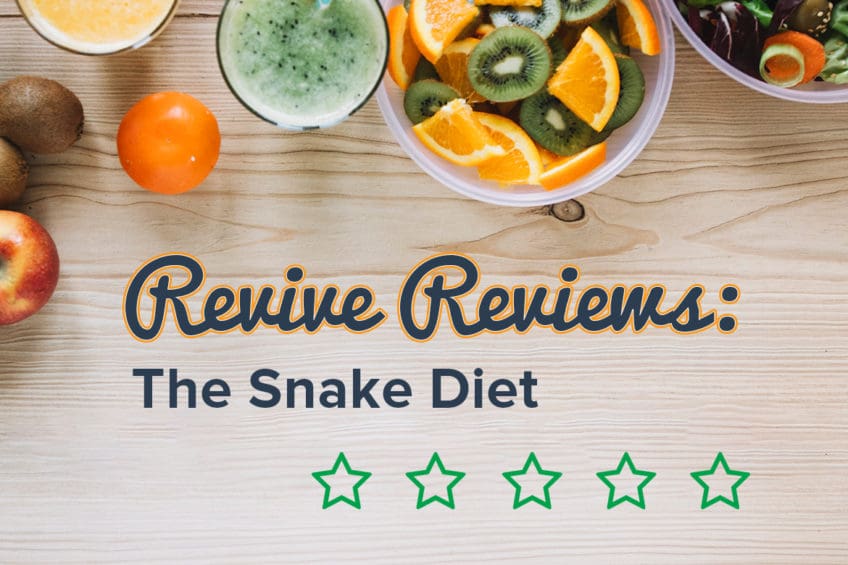The Snake Diet Reviewed by a Dietitian
DISCLAIMER: the content referenced in this blog post may be offensive to some individuals as it contains swearing, body-negativity, and material that could be triggering for some. If you wish to seek out the Snake Diet and its content online, please do so at your own discretion. Rest assured, the potentially offensive content will be kept out of this blog, with emphasis kept on the methods, science, and rationale of the diet.
What is the Snake Diet?
The Snake Diet is a “fasting-focused lifestyle” based on the concept of prolonged fasting, the act of fasting without food for long periods of time, and intense intermittent fasting, an eating pattern that only allows for small eating windows (in other words, you only get between 2-4 hours to eat during the day). This is similar but still different to classic or mainstream intermittent fasting where the eating window is 6 -10 hours.
The steps to start the Snake Diet are a bit ambiguous. The website provides three phases by which one would transition to this eating pattern, but as shown in the videos that explain the methods of the Snake Diet, there is a lack of clarity as to the direction someone would take. Nonetheless, the basic points of the three phases are:
1: Sugar Addiction Rehab
This phase is characterised by a 48-hour fast wherein you will only consume a drink called “Snake Juice”. This is where the Snake Diet can be commonly named the “Snake Juice Diet”. Snake Juice is simply a water-based beverage with Himalayan pink salt (a sodium source) and Salt-Free/No-Salt (a potassium source) mixed in.
The basis for this phase is to help your body “beat sugar and food addictions” and to force your body quickly into ketosis. Ketosis is a metabolic-state in which your body breaks down fat into a by-product called ketone bodies to be used as energy, instead of the normal energy source of the sugar compound glucose.
2. Weight Loss and Cleansing Phase
After the initial 48-hour fast, there are a couple options. First, a person could begin consuming very low carbohydrate meals mostly made up of vegetables and a small amount of meat and fat. After consuming some of these meals, a person is to complete a 72-hour fast, again using Snake Juice. The second option is for a person who is “feeling good” after the initial 48-hours; they could turn the 48-hour fast into a 72-hour fast or even a 96-hour fast.
As mentioned multiple times throughout the videos, if someone is not losing weight during this phase, the advice is to “fast longer and eat less”.
3. Maintenance
After the first two phases, an individual would fluctuate between intense intermittent fasting (allowing themselves a roughly 2-hour eating window per day and fasting for the rest) and prolonged fasting (periodically going multiple days without food). One of the major points of the fasting focussed lifestyle is to eat proactively, in other words eating an amount of food one day that reflects the amount of time a person anticipates they will be fasting.
Some Points to Consider
Long story short, I would not recommend attempting to follow this diet. There are many issues I have with the diet and the way it is conveyed to the public. Here are some issues I have with it:
1. Use of Anecdotal Evidence
As evidenced by the many videos made about the Snake Diet, it would seem that many of its methods are based on personal experiments. It is my hope that there is at least some degree of individualization of programs based on different people’s bodies their individual needs. Granted, fasting is a well-known practice, but to use predominantly anecdotal claims when supporting one’s methods does not provide much in terms of scientific merit.
2. Lack of Reference to Scientific Research
There is no reference made to any sort of scientific journal article or study. Normally, a diet or program such as this would have an area on its website containing information about its scientific basis, but there is no sign of this. What does show up in a couple videos is the use of a logical fallacy known as the “burden of proof”, wherein a person making a specific claim indicates that the burden of proof lies not with them but with other people to prove/disprove. In other words, instead of referencing peer-reviewed scientific research, statements such as “do your own research” are used.
It is also suggested that the Snake Diet mimics the actions of our ancestors from the hunter-gatherer times, since humans back then constantly fasted due to the long periods in between finding food. As a result, we are hardwired to withstand long fasts. However, a break in logic occurs here since something done out of survival is not always the same as something that is optimal for health “just because our ancestors did it”.
3. Lack of Practicality and Sustainability
For the average person (who has a busy job with an average activity level and has a social life) an eating pattern such as this would be difficult to adhere to. For one, fasting all the time, either intermittently or for prolonged periods of time, likely is not conducive to a busy lifestyle. Eating less would naturally mean saving the time normally spent at meals and snacks and using it elsewhere. But eating less also means taking in less energy to be functional. Productivity would likely decrease as a result, which is not usually viewed in a positive light by employers and fellow employees. Second, less energy intake means less energy to partake in physical activity, especially intense physical activity. Fuelling properly for exercise allows a person to have optimal energy levels for an exercise session and recover adequately for the next one. Fuelling improperly increases perceived exertion and negatively impacts the likelihood that someone will continue to exercise.
4. Could Trigger Unnecessary Psychological Stress
Without a doubt, this eating pattern will create some sort of unnecessary mental stress for an individual. To adhere to such strict and intense fasting protocols is something that most peoples lifestyles (even those who are free from ailments) do not support. This is not out of laziness either.
It is important to consider the social aspects of food and eating as well. As we have talked about in the past, eating is social act; it is something we share with family and friends. For many people social gatherings and food go hand-in-hand, not out of necessity, but out of pure enjoyment. The mental angst that would likely come about in response to constantly having to decline eating with other people, or even declining to attend these events, is something that no person should have to endure.
Most importantly, if an individual already has issues with body image the messaging contained within this diet could be internalized and could do a lot of damage mentally. Even if someone does not have prior issues with body image, there is no guaranteeing that issues will not arise after consuming the Snake Diet’s media content.
Final Thoughts
There is no “one-size-fits all” when it comes to eating patterns, and on the other hand there is rarely a “this-size-fits-nobody”. But the extreme lengths someone would have to go to adhere to this lifestyle seem glaringly unjustifiable, no matter how much weight one will lose with it. There is more to human beings than weight and body composition; to suggest otherwise would be a little barbaric. In my professional opinion, attempting to follow a diet such as the Snake Diet would probably bring about more harm than good. I fail to see how most people would find it practical, safe from a physical and mental perspective, and sustainable in the long term.
By Brandon Gruber, Dietitian
Ready to Ditch the Diet for Good?

